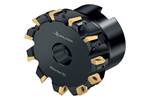Cermet Turning Inserts Delivers Exceptional Surface Finish and Reduced Vibration Tendency
The new PVD-coated cermet grade WEP10C, along with FP2 geometry from Walter USA, boosts productivity and dimensional stability in mass production.
Share
Read Next

Photo Credit: Walter USA
The PVD-coated, cermet-grade WEP10C and FP2 geometry from Walter USA are indexable turning inserts designed for applications where a soft cut and high precision is required. They are well suited for finishing thin-walled components, components with small diameters, long components, and components with unstable clamping as well as fine-boring applications.
The FP2 geometry features a high positive (18-degree) rake angle geometry with soft hone for reduced cutting forces and vibration tendency. The WEP10C’s multilayer TiCN TiAlN PVD coating and fine cermet micro grain enhances tool life. The combination of edge preparation and grade is said to ensure dimensional stability over long periods of time, boosting productivity in mass production
Walter’s FP2 geometry also uses “minus tolerance” or “maximum corner radius” tolerance. Walter says this enables a stronger corner radius to be presented than a standard ISO/ANSI corner radius. For example, an ANSI-0.5 corner radius (0.0078") is typically required to machine a shoulder with 0.0157" corner radius. However, with the FP2 geometry, a 1M tolerance (equivalent to ANSI 0.0157" but with 0.0146"+/-0.0008" tolerance corner radius) can be used. Surface finish is said to be improved as a result.
Related Content
-
Revisiting Some Hot Runner Fundamentals
What exactly does a hot runner do? If you’ve been in the injection molding industry for any length of time, you might think the answer is obvious, but it is not.
-
The Ins and Outs of Hot Runner Temperature Control
A training checklist that explains the why and how of proper hot runner temperature control and system management.
-
The Benefits of Hand Scraping
Accuracy and flatness are two benefits of hand scraping that help improve machine loop stiffness, workpiece surface finish and component geometry.






.png;maxWidth=300;quality=90)





